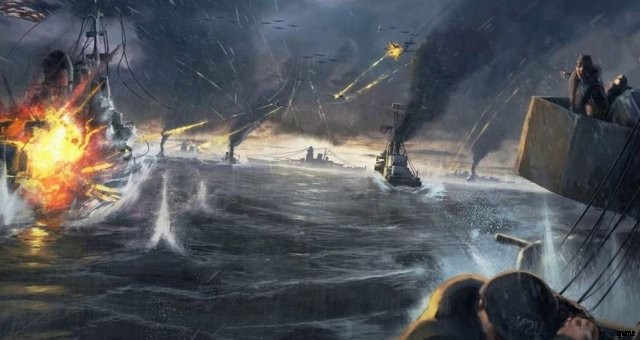
Das Teilungsvorlagensystem ist eine der Schlüsselmechaniken von Hearts of Iron IV. Eine Division ist 1 Basiseinheit, die während des Spiels auf der Karte dargestellt wird. Die Zusammensetzung jeder Abteilung wird durch ihre Abteilungsvorlage festgelegt. Divisionsvorlagen können vom Spieler erstellt und modifiziert werden, indem er Armeeerfahrung ausgibt. Die Zusammensetzung Ihrer Division kann eine Schlacht entscheiden oder brechen.
Andere Hearts of Iron IV-Guides:
- 100 % Leistungsleitfaden.
- Wie man den Zweiten Weltkrieg für neue Spieler ganz einfach gewinnt.
- Empire of Japan Guide.
Wo und wie Abteilungsvorlagen bearbeitet werden
Sie können Abteilungsvorlagen bearbeiten, indem Sie zu:
Recruit &Deploy -> Klicken Sie dann in der gewünschten Abteilung auf „Bearbeiten“.
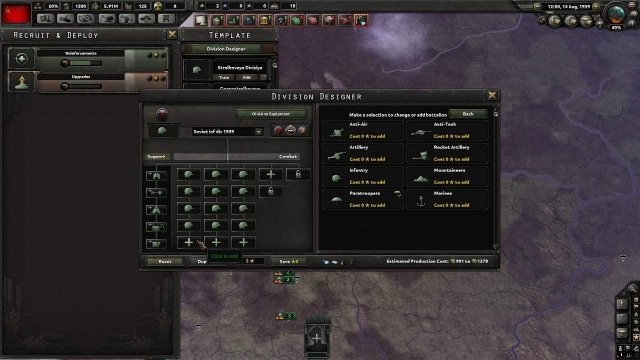
Jede Division hat eine Divisionsvorlage.
Hier ist ein Beispiel für eine Divisionsvorlage mit 7 Infanterie und 2 Artilerien:
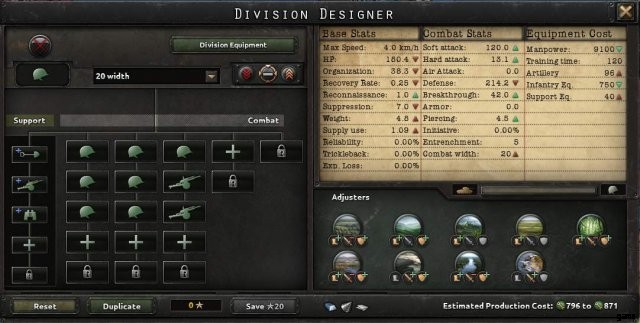
Zurücksetzen -> Setzen Sie die Änderungen zurück, die Sie vorgenommen, aber noch nicht gespeichert haben.
Duplizieren -> Erstellen Sie eine weitere Divisionsvorlage wie diese, ohne Armeeerfahrung auszugeben, nützlich, wenn Sie eine neue Divisionsvorlage erstellen und diese behalten möchten.
Die 3 Pfeile -> Rot ist für Backup-Einheiten, sie sind die letzten, die hochwertige Ausrüstung erhalten, weiß ist für normale Einheiten und gelb ist für Elite-Einheiten, sie sind die ersten, die hochwertige Ausrüstung erhalten (neue Waffen oder wenn Ihnen Ausrüstung fehlt, werden sie es tun als erster gefüllt werden). Sie können manuell auswählen, welche Divisionen Sie als Elite, Normal oder Backup betrachten.
So sieht eine Division aus:
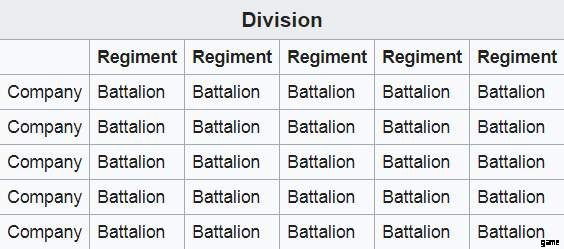
- Jede Division besteht aus bis zu 5 Kampfregimentern und 5 Unterstützungskompanien.
- Jedes Kampfregiment besteht aus bis zu 5 Bataillonen.
- Es kostet 5 XP, einer Division ein Bataillon hinzuzufügen, unabhängig davon, ob es sich um dasselbe oder ein neues Regiment handelt.
- Das Hinzufügen eines Bataillons eines anderen Einheitentyps (Infanterie, mobil oder gepanzert) fügt eine Strafe von 20 EP pro zusätzlichem Einheitentyp hinzu.
- Eine Division kann für Bataillone eine beliebige Anzahl desselben Einheitentyps haben, aber nur eine von jedem Einheitentyp für Unterstützungskompanien.
- Eine Divisionsvorlage kann als Reserve, Regular oder Elite angegeben werden. Elite-Divisionen werden für bessere Ausrüstung priorisiert, gefolgt von regulären Divisionen und schließlich Reserven.
- Jede Abteilungsvorlage kann bestimmte Arten von Ausrüstung erhalten, wenn mehrere Arten verfügbar sind. Ein Beispiel wären Elitedivisionen, die nur die neuesten Waffen verwenden, und Reservedivisionen, die die ältesten verwenden.
Der Statistikbildschirm und die Basisstatistiken
Basisstatistiken, Kampfstatistiken sind Ausrüstungskosten, die sich auf der rechten Seite der Divisionsvorlage befinden. Dies sind die Statistiken für die Division 7 Infantry – 2 Artilery von oben.
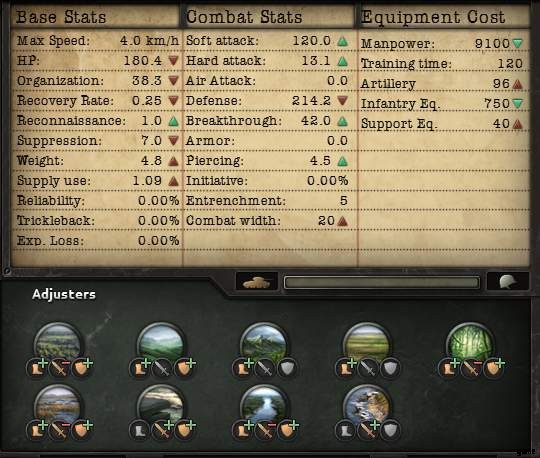
Die Statistiken können sich basierend auf Ihren nationalen Ideen oder abgeschlossenen Recherchen ändern.
Generell sind höhere Werte besser, außer für Gewicht, Verbrauch und Kampfbreite.
Ich. Basisstatistiken
Höchstgeschwindigkeit -> Die maximale Basisgeschwindigkeit, die eine Einheit erreichen kann. Dieser Wert ist normalerweise aufgrund von Gelände- und Infrastrukturmodifikatoren niedriger, jedoch erhöhen bestimmte Dinge wie Ingenieure diese.
HP (Lebenspunkte) -> Wie viel Schaden deine Einheit im Kampf erleiden kann. Infanterie und Varianten haben viel davon, weil sie viele sind, während Rüstungen sehr wenig haben.
Organisation -> Das ist sehr wichtig. Es ist die Fähigkeit Ihrer Einheit, den Kampf aufrechtzuerhalten. Es ist wichtig, es im Hinterkopf zu behalten, aber es nicht dazu zu bringen, die Zusammensetzung Ihrer Einheit zu diktieren. Wird hauptsächlich von Infanterie und motorisiert oder mechanisiert bereitgestellt. Es liegt normalerweise zwischen 25 und 60.
Wiederherstellungsrate -> Wie schnell Ihre Einheiten die Organisation wiedererlangen. Die Erholung ist genauso wichtig wie die Organisation. Da die meisten Einheiten, die für Erholung sorgen, aber auch für Organisation sorgen, halten sich diese Werte meist die Waage. Er liegt normalerweise zwischen 0,30 und 0,44.
Aufklärung -> Hohe Aufklärung erhöht die Chancen einer Einheit, eine Kampftaktik zu wählen, die der gewählten Taktik des Feindes besser entgegenwirkt. It is only affected by 2 things:whether you have support battalions &whether you have Shock&Awe research of the Superior Firepower doctrine or Infiltration in Depth of the Grand Battleplan doctrine. Both of these doctrines are at or near the very end of their trees, thus your recon value is usually equal to your recon batallion’s level with values between 1 and 7 with an absolute maximum of 8.
Suppression -> Whether you’re albe to keep the revolts in an occupied territory in check. Suppression has very few things that affect it, cavalry is good for suppression, providing 2 per cavalry while most other units provide 1 and the Military Police provides a 10% modifier to the unit value. In combat it doesn’t offer anything and is pretty neglectable.
Weight -> How many convoys it takes to ship your unit. Only important for countries that have to ship their units by sea. Very closely related to Supply Use, but then without any actual meaning.
Supply Use -> How much supply use your units use (press F4 in game to see the supply lines), which directly translates to how many units you can have in any given province. As a general rule:Infantry uses very little supply, tanks use a lot of supply, Logistics Company support company is indispensible.
Reliability -> Affected only by the Maintenance Battalion, Reliability is a modifier to the base reliability of a vehicle (such as the effect of a tank designer). This applies to vehicles only. As far as I can tell it affects mostly during attrition, and doesn’t appear to have the same combat effects as reliability does for ships.
Trickleback &Exp.Loss -> Trickleback is how many casualties are returned to your manpower pool and exp.loss is how much experience is lost when these casualties are replaced by fresh men. They only change with the use of a Field Hospital battalion. This makes the Field Hospital support company extremely important for nations with a low manpower pool.
Combat Stats and Equipment Cost
II. Combat Stats
Soft Attack -> A unit’s ability to deal damage. As a general rule:Infantry has very low soft attack, tanks have pretty low soft attack, artillery and SPG units have insanely high soft attacks. Most people, and especially the AI, build an army consisting 90-100% of infantry, infantry is very soft and thus soft attack is one of the very most important stats you look at.
Hard Attack -> A unit’s ability to deal hard damage to tanks and mechanized units. Tanks and Anti-Tank guns have high hard attack.
Air Attack -> A unit’s ability to shoot at planes. Support AA (Support battalion) is more cost-effective than line-AA for air-attack purposes. Support AA or Line-AA is the most cost-effective (production-wise) AA when you take the researches for this.
Defense -> A unit’s ability to not break under attack. Absorbing damage that would otherwise have gone to a unit’s organization. This value is provided primarily by Infantry and derivatives. For armored units, this alone makes motorized or mechanized indispensible as without it your units are simply unable to defend.
Breakthrough -> A unit’s ability to break the enemy units under attack. Breakthrough is less relevant than defense for the typical player as you want to hold the ground that you take, having enemies bleed off their organization on the attack and counter-attacking to maintain momentum in a push. It’s usually around 150.
Armor -> A unit’s ability to resist the enemy’s piercing. When the enemy cannot pierce, you take 50% less damage, 50% less organization loss and you deal 50% more organization loss to the units you are facing, this bonus is applied to your entire division. Thus, armor alone can make a unit work, even if on paper it seems hopelessly outclassed. Armor values are one of the things that develop extremely quickly between armored vehicles. Not very useful unless you have enough of it.
Piercing -> All piercing does is deny the enemy the bonuses armor could provide him. Units with the highest piercing are tank destroyers followed by regular tanks. Although infantry anti-tank provides good piercing to all infantry units it will prove insufficient if you are facing a clever enemy in multiplayer, as the piercing bonus is based on a percentage value and will have a limited impact on actual stats.
Initiative -> The reinforce rate and planning speed. It is affected only by the signal company, and seems to have very little tangible impact on battles other than the planning bonuses.
Entrenchment -> Affected only by the Engineer Company support battalion, Entrenchment affects how much and how fast a unit gets entrenched. Very similar to Recon, Reliability and Initiative, there are very few things that affect this value, and it is universal regardless of which line units you employ. While Field Marshalls with “Defensive Doctrine” affect maximum entrenchment it is not represented in this stat.
Combat Width -> How much space the unit takes on the battlefield. A typical fight has 80 combat width, thus you could fit 8 units of 10, 4 units of 20, 2 units of 40 or 1 unit of 80. Each combat width range is representative of an approach to the game. When you make many units of 10 combat width, you increase the density of support battalions on the field, effectively increasing your entire army’s effectiveness at no additional cost of combat width. The 40 combat width aims to get the most out of its line units. The 20 combat width is the balanced method. If you get a Field Marshall with Offensive Doctrine, which reduces the combat width of all units under his command by 10%, you can create units of 11, 22 and 44 combat width respectively and have them all act as if they are 10, 20 and 40 combat width.
III. Equipment Cost
Manpower -> How many people your division employs. More men in the division means more men on the battlefield and bigger casualty numbers. Typically you want to keep this number as low as possible, but at no point should this be your main aim as it is hard to impossible to balance out. As a general rule, line-artillery units and armor take 500 men per unit in your division, infantry takes 1000 and motorized &mechanized take 1200.
Training Time -> There are two versions of training time, 120 and 180. 120 is for infantry and 180 for tanks. This is a time listed in days, but since Armor =180, Infantry =120, you just have to take this value as it is.
Equipment numbers -> All the individual numbers of vehicles and other equipment you would require to produce this division template. It is here that you can make a good estimate of how to distribute your overall production.
IV. Additional Stats
Hardness (the bar below the division template) -> The ratio of damage you take. If your unit has 43% hardness you take 57% soft attack and 43% hard attack. For example, if you are being attacked by a unit with 1000 soft attack and 200 hard attack, you will receive (1000 * 0.57) + (200 * 0.43) =656 damage.
Estimated Production Cost -> The minimum and maximum estimated production cost of a unit. These values represent the overall production cost in industrial capacity of your unit, and do not represent the material requirements of each division. Naturally a lower cost is better.
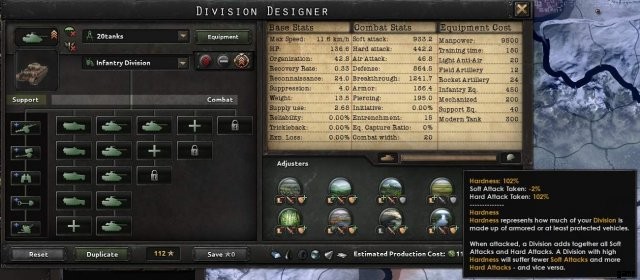
Infantry Divisions
20 width 7/2 divisions -> 7 infantry and 2 artillery battalions. Good starter division, but is completely outclassed by 40 width divisions in almost every situation. Still good in low supply areas like Africa or Asia.
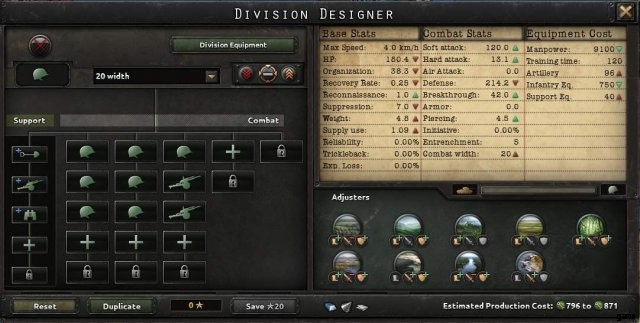
20 width 6/2/1 divisions -> 6 infantry, 2 artillery and 1 Light Tank Destroyer of year at least 1936. The goal being to provide an armor bonus against the majority of AI and maybe even player builds while providing piercing to beat up any armor that may be encountered along the way. This does not work with the 1934 Light Tank Destroyer version.
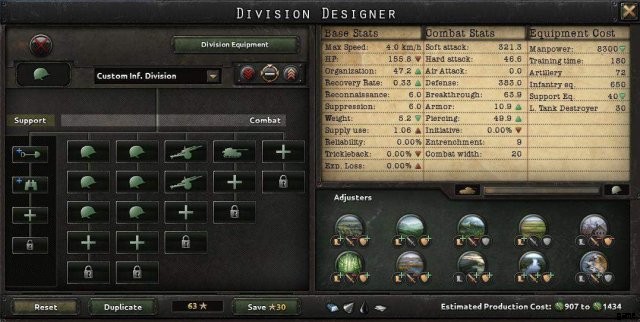
The 40 width divisions outclass 20 width divisions because of how criticals are calculated. The 40 width divisions do more damage at the expense of having half the organization of 20 divisions because they have the same, but it’s only 1 division instead of 2 divisions, however they deal 4-5 times more damage, so the tradeoff for using 20’s is barely worth it. This generally leads to faster fights if both of you are fighting with 40’s. 20’s on the other hand might not do so much damage but will hold the line for longer. This in turn makes your enemy take more attrition damage so don’t underestimate 20’s defensive power, especially in wide theaters. Most people like to have a line of 20’s as the front and then a smaller army of 40’s to do the pushing.
40 width 14/4 divisions -> 14 infantry and 4 artillery battalions. This is preferable to the above division, especially if you’re fighting in Europe.
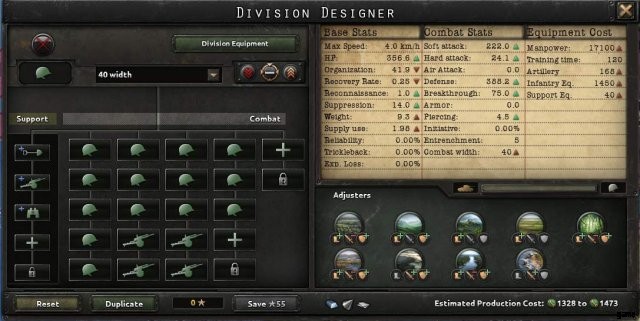
40 width 13/4/2 divisions -> 14 infantry, 2 artillery and 2 anti-tank battalions. These are good if you’re fighting against tanks and aren’t looking to abuse space marine divisions (see below.)
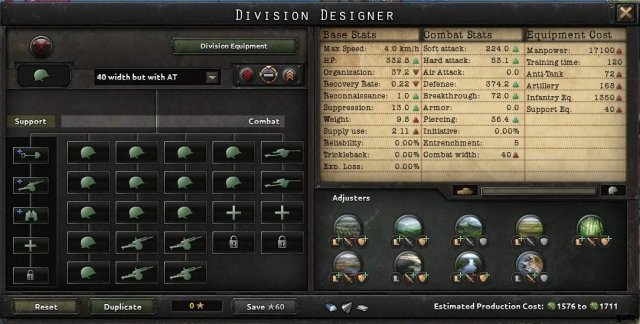
BROKEN/OP:40 width 13/2/1 divisions “Space Marines” -> 13 infantry, 2 artillery and 1 Heavy Tank Destroyer battalion. These are usually banned in multiplayer games as they are completely game breaking. The AI basically never builds enough AT to counter the extra armor you have on these infantry divisions.
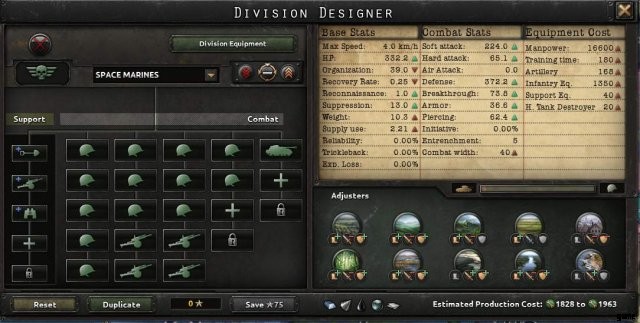
Tank Divisions
20 width 6/4 division -> 6 medium tank and 4 motorized battalions. Maintenance companies are good on your armored divisions to reduce attrition losses.
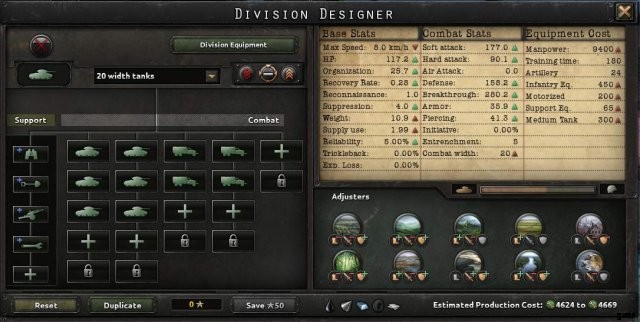
40 width 15/5 division -> 15 medium tank and 5 motorized battalions. Higher production cost, but these divisions are nearly unstoppable. Probably banned in most MP games, and will destroy anything they face in singleplayer.
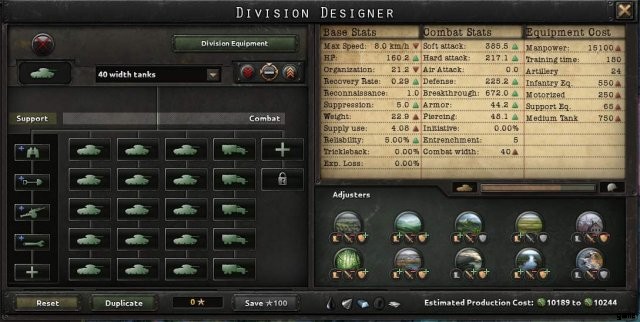
Ending Tips
Maintenance companies &Attrition -> Attrition is mostly caused by terrain not supply. So if you are fighting in the jungle, desert or mountains you will suffer a lot of attrition. Maintenance companies will reduce attrition taken. You can also just accept the losses taken.
AA divisions &Strategic Bombers -> No division AA only protect the divisions they are in and not the province or anything else. They reduce the defense and speed penalty from enemy air superiority. They will also shoot down close air support engaged. But they have to be engaged inside combat.
Breakthrough &Defense -> Breakthrough is identical to defense in function. When you are on the offensive you use breakthrough when on the defense you use defense. These just reduce damage taken. There is a limit as every defense can only reduce 1 point of enemy attack.
Mechanized &Heavy Tanks -> Mechanized are a defensive upgrade for tanks with a secondary role of AT. Hardness greatly reduce damage infantry/mediums can do, defense helps protect from counter attack, and HP reduces losses. The higher the tech and more tanks the better these are. Heavy tanks provide armor, and AT mostly at the cost of speed. You only need 1 heavy tank to get the majority of armor at the cost of speed.
40 width &20 width -> 40 width is stronger in most situations. It’s less flexible but stronger in combat.
